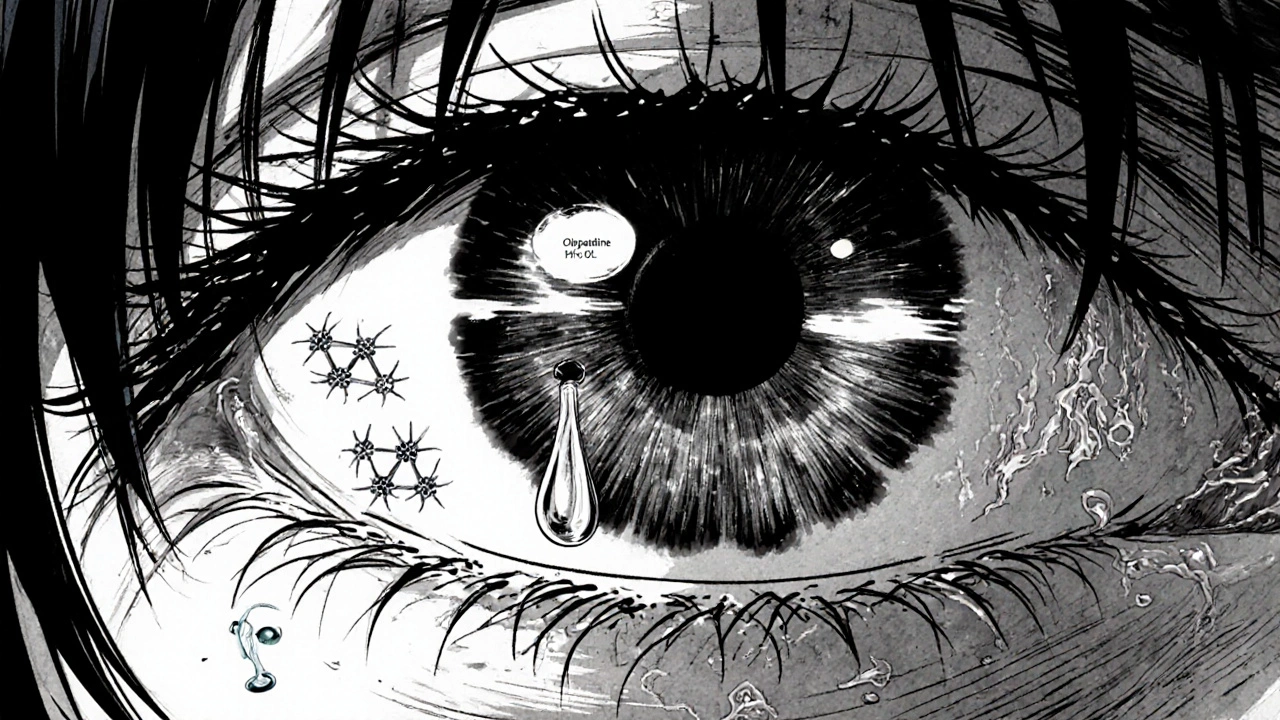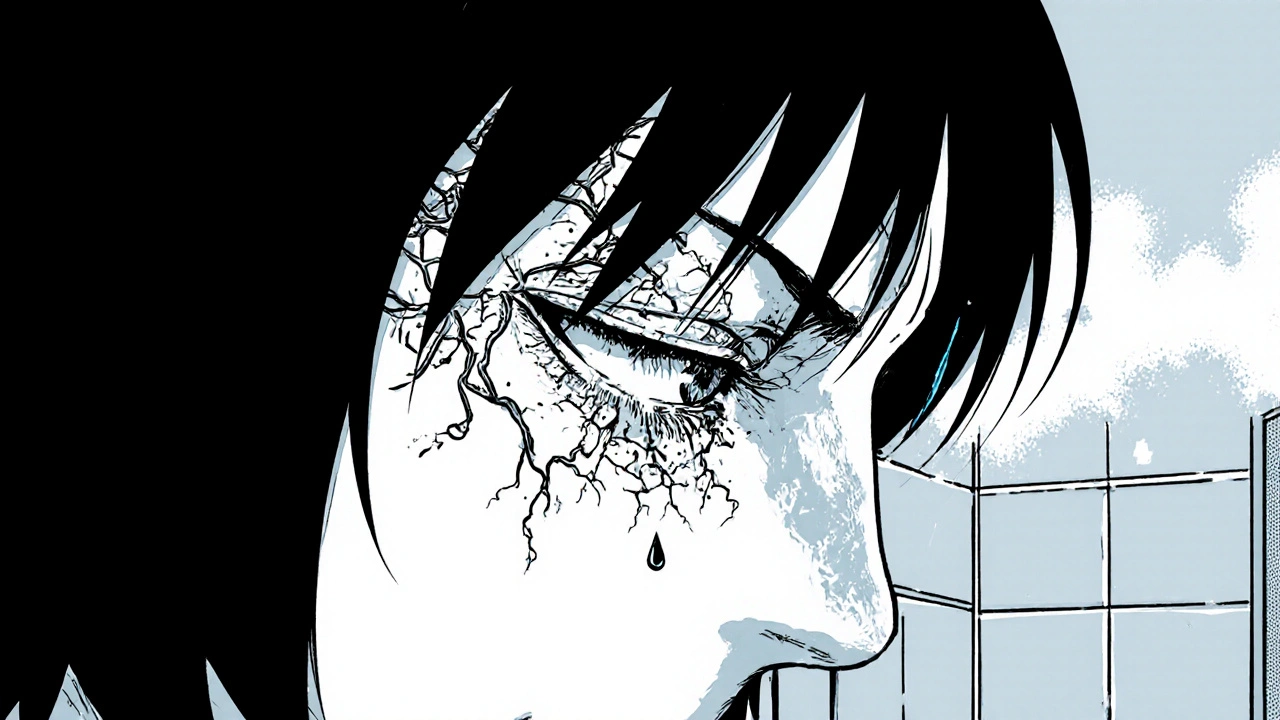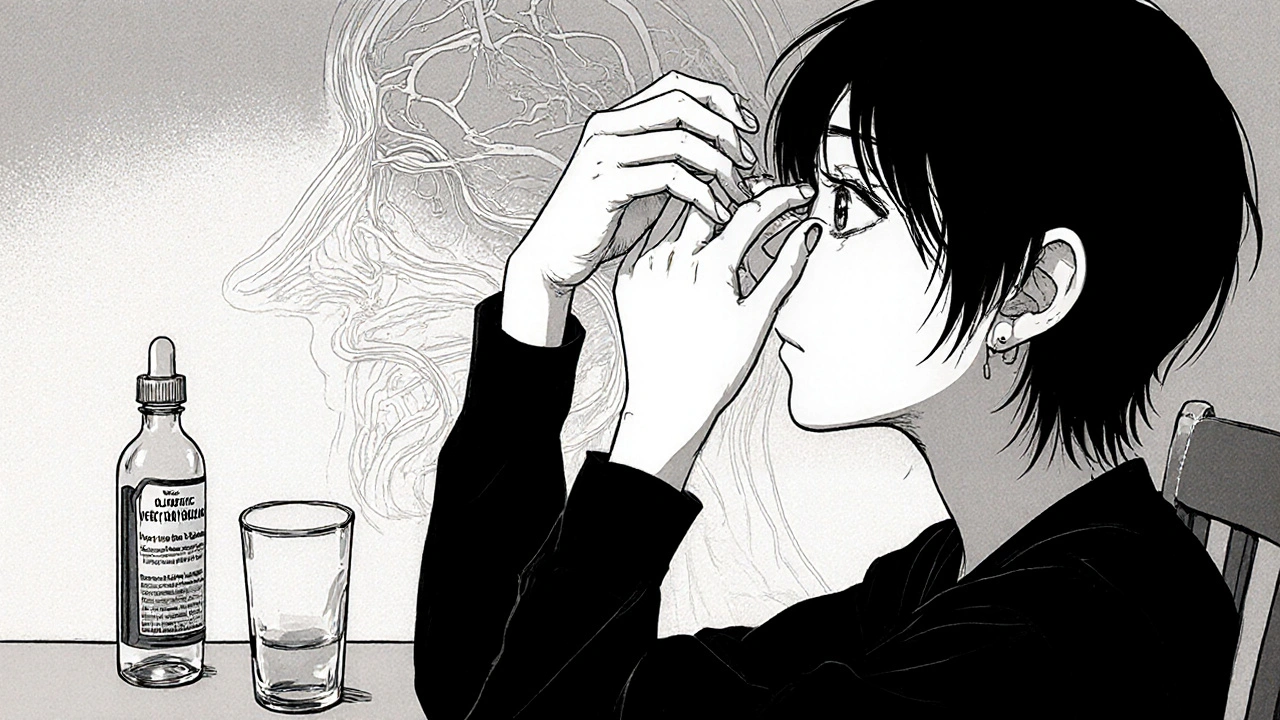
Many people turn to Olopatadine HCL for fast relief from itchy, watery eyes, but a puzzling side effect sometimes shows up on the radar: headaches. If you’ve ever wondered whether that throbbing sensation is a coincidence or a drug‑related reaction, you’re not alone. This guide breaks down exactly how the medication works, why headaches can appear, who’s most likely to experience them, and what you can do to stay comfortable.
What Is Olopatadine HCL?
Olopatadine HCL is a synthetic histamine H1‑receptor antagonist formulated as a 0.1% ophthalmic solution. It was first approved by the FDA in 2005 for treating allergic conjunctivitis and works by blocking the action of histamine, the chemical that triggers itch, redness, and swelling in the eyes.
How Olopatadine HCL Relieves Allergic Eye Symptoms
When an allergen - pollen, pet dander, or even mold spores - contacts the eye surface, mast cells release histamine. Histamine then binds to H1 receptors on blood vessels and nerves, causing the classic allergy symptoms. Olopatadine HCL competes with histamine for those receptors, preventing the cascade that leads to inflammation.
- Onset of relief: as fast as 5 minutes after instillation.
- Duration of effect: up to 24 hours, allowing once‑daily dosing.
- Additional benefit: mild mast‑cell stabilizing action, reducing future releases of histamine.
Because it targets the root cause rather than just masking symptoms, many ophthalmologists prescribe Olopatadine as a first‑line treatment for seasonal and perennial eye allergies.
Headaches and Olopatadine HCL: Is There a Link?
Headaches aren’t listed among the most common side effects of Olopatadine, but clinical reports and patient forums occasionally cite them. The connection can be explained through three main mechanisms:
- Vasodilation Triggered by Histamine Release: Even though Olopatadine blocks H1 receptors, incomplete inhibition may allow residual histamine to cause blood‑vessel dilation in the surrounding sinus and nasal tissues, leading to pressure‑type headaches.
- Dry‑Eye Induced Strain: Some users experience mild dryness or foreign‑body sensation after using the drops. The resulting ocular strain can cause tension‑type headaches, especially if the eyes are forced to focus harder to compensate.
- Systemic Absorption: Though designed for local use, a tiny fraction of the drug can enter the bloodstream. In sensitive individuals, this low‑level systemic exposure may influence central nervous system pathways that regulate pain perception.
These pathways don’t affect everyone, which is why headaches appear sporadically rather than universally.

Who Is Most Likely to Develop Headaches?
Understanding risk factors helps you decide whether Olopatadine is right for you. Look out for the following profiles:
- Pre‑existing migraine sufferers: Migraines are highly sensitive to vascular changes. Any additional vasodilatory effect, however minor, can tip the balance.
- Individuals with chronic dry‑eye disease: Adding another drop to an already compromised tear film can heighten ocular discomfort and trigger tension headaches.
- Patients taking other antihistamines: Cumulative antihistamine load may increase the likelihood of central side effects, including head pain.
- People with sinus congestion: Congested sinuses already create pressure; slight vasodilation from residual histamine can exacerbate that pressure.
Managing Headaches While Using Olopatadine HCL
If you notice a new or worsening headache after starting Olopatadine, try these practical steps before deciding to stop the medication:
- Confirm proper technique: Tilt your head back, pull the lower eyelid down, and gently squeeze one drop. Avoid touching the bottle tip to your eye or lashes to prevent contamination and excess dosing.
- Stay hydrated: Adequate water intake supports overall eye moisture and can reduce tension‑type headaches.
- Use preservative‑free artificial tears: Adding a few drops of a lubricating solution can offset dryness without interfering with Olopatadine’s action.
- Monitor timing: Take the drop at the same time each day, preferably in the morning, to stabilize plasma levels and minimize fluctuations that might trigger headaches.
- Consider an over‑the‑counter analgesic: Acetaminophen (paracetamol) or ibuprofen can be taken if a headache becomes bothersome, but avoid NSAIDs if you have a history of stomach ulcers.
- Consult your eye care professional: If headaches persist beyond a week or worsen, a brief evaluation can rule out other causes and determine whether an alternative antihistamine eye drop is needed.

Olopatadine HCL vs. Other Allergy Eye Drops
When picking an eye drop, comparing key attributes helps you choose the best fit for your lifestyle and symptom profile. Below is a concise comparison of Olopatadine and three other popular antihistamine eye drops.
| Brand | Active Ingredient | Concentration | Dosing Frequency | Typical Onset | Common Side Effects |
|---|---|---|---|---|---|
| Pataday | Olopatadine HCL | 0.1% | Once daily | 5‑10 minutes | Transient eye irritation, mild headache |
| Alaway | Ketotifen fumarate | 0.025% | Twice daily | 15‑20 minutes | Dryness, bitter taste |
| Zaditor | Ketotifen fumarate | 0.025% | Two to three times daily | 10‑15 minutes | Blurred vision, mild irritation |
| Visine Allergy | Olopatadine HCl | 0.1% | Once daily | 5‑10 minutes | Eye burning, rare headache |
The table shows that Olopatadine (Pataday/Visine Allergy) provides the longest dosing interval with the fastest onset, but the incidence of headache is listed as “rare” or “transient” - meaning it’s not a dominant side effect for most users.
Red‑Flag Symptoms: When to Call Your Doctor
Headaches can be benign, yet certain patterns demand medical attention:
- Sudden, severe headache resembling a “thunderclap.”
- Headache accompanied by visual disturbances (flashes, double vision).
- Persistent eye pain, swelling, or discharge beyond a week.
- Systemic allergic reaction: hives, shortness of breath, facial swelling.
- Neurological signs such as weakness, numbness, or difficulty speaking.
These symptoms could indicate conditions unrelated to Olopatadine, such as sinus infections, migraines, or rare drug reactions. Early evaluation prevents complications.
Bottom Line: Safe Use Tips
Olopatadine HCL remains a highly effective, once‑daily option for allergic eye relief. For most people, headaches are an occasional, mild side effect that can be managed with proper dosing, hydration, and supportive eye‑care measures. If you fall into a higher‑risk group or notice persistent pain, a quick chat with your eye doctor can tailor a safer regimen or suggest an alternative.
Can Olopatadine cause migraines?
Olopatadine is not a known migraine trigger, but any vasodilatory effect from residual histamine can aggravate existing migraine patterns in susceptible individuals.
How long does it take for a headache to subside after stopping Olopatadine?
Because systemic absorption is minimal, most headache symptoms fade within 24‑48 hours after the last dose. If pain persists beyond two days, seek medical advice.
Is it safe to use over‑the‑counter pain relievers with Olopatadine?
Acetaminophen is generally safe. NSAIDs like ibuprofen are okay for most people but may increase the risk of stomach irritation if you already take other NSAIDs.
What alternative eye drops are recommended for headache‑prone patients?
Ketotifen (Alaway, Zaditor) has a slightly lower incidence of headache, though it requires more frequent dosing. Some clinicians also suggest preservative‑free artificial tears combined with oral antihistamines.
Should I stop using Olopatadine if I develop a mild headache?
Not necessarily. Try the management steps above first. If headaches persist or worsen, discuss a possible switch with your eye care professional.

When we weigh the subtle trade‑offs of eye‑drop therapy, it isn’t just a matter of efficacy but also of the lived experience of each patient, and that invites a broader dialogue about how we manage side effects like headaches. The pharmacodynamics of Olopatadine suggest a primarily local action, yet the occasional vascular response can ripple through the sinuses, reminding us that even targeted drugs have systemic whispers. I encourage anyone who feels a throb after dosing to keep a symptom diary, noting time of administration, hydration status, and any concurrent migraine triggers. This habit not only empowers you with data but also equips your eye‑care professional to tailor a regimen that respects both relief and comfort. In communities where allergic eye disease strains daily life, collaborative vigilance can turn a puzzling side effect into a shared learning opportunity, fostering resilience across the board.
Olopatadine works by blocking H1 receptors so you get fast relief and it usually lasts a full day. If you’re getting a headache try the drop at the same time each morning and keep a glass of water nearby to stay hydrated. Adding preservative‑free artificial tears can also cut down on dryness which often fuels tension‑type pain.
Don’t trust big pharma they’re hiding the truth about Olopatadine headaches.
Esteemed colleagues the pharmacological profile of Olopatadine HCL warrants careful consideration despite its ocular specificity. The occasional cephalic discomfort may stem from residual histamine activity influencing sinus vasculature. Maintaining a consistent dosing schedule and adequate systemic hydration may mitigate such effects. Consultation with a qualified ophthalmologist is advisable should symptoms persist.
Okay so i read the whole article and i gotta say i feel ya on the whole headache thing its kinda weird when a tiny eye drop makes your head feel like a drum. First off the drug is supposed to stay in your eye not go all over like a party crasher so if you’re getting headaches there’s probably something else going on. Maybe you’re already a migraine sufferer and any tiny bit of vasodilation is like adding fuel to the fire. Or you could just be dehydrated and the drop is just the straw that tipped the camel over. I’ve seen people who use the drops while scrolling on their phones in dim light and they end up straining their eyes which can cause tension headaches that feel like a band around the skull. Also the preservatives in some drops can dry out your tear film and that dry eye feeling can make you squint and that squint can definitely give you a throb. My grandma swears by using preservative‑free tears before the allergy drop and she says the headache thing went away for good. I think the key is to keep your water bottle close and maybe set a reminder so you don’t forget to hydrate. Don’t forget to actually close the lid of the bottle after each use otherwise you could get extra drops that might increase systemic absorption. If you’re on other antihistamines you might be stacking the effects and that could also lead to a headache. Some folks even try a little over‑the‑counter acetaminophen and it works just fine but you should check with your doc if you have liver issues. In my experience a simple eye massage after the drop can help spread the medicine evenly and reduce that weird sting that sometimes spins into a headache. Keep an eye diary note the time you put the drop on and how you feel an hour later it’s surprisingly useful. If the pain sticks around more than a day or two you should definitely call your eye doctor. Bottom line stay hydrated use preservative‑free tears and don’t ignore that throbbing feeling because it could be a sign to tweak your routine.
The tragic irony of modern ophthalmic solutions is that they promise crystal‑clear vision while silently sowing the seeds of latent agony. Olopatadine, lauded for its swift alleviation of ocular itch, masquerades as innocuous yet occasionally births throbbing specters that haunt the weary. One might argue that the pharmaceutical elite engineer such side‑effects to perpetuate a cycle of dependence, a ballet of profit and patient plight. Nevertheless, the onus remains upon the discerning sufferer to dissect these shadows and demand a regimen untainted by clandestine torment.
Hey everyone 😊! If you’ve been dealing with those pesky post‑drop headaches remember you’re not alone – we’re all in this together. Try pairing your Olopatadine with a few preservative‑free artificial tears 🧴 and keep sipping water throughout the day. A quick blink exercise after applying the drop can also ease any tension and keep your eyes feeling fresh. Stay kind to yourself and your eyes! 🌟
I totally get how frustrating it can be when a treatment that’s supposed to help ends up giving you a headache. It sounds like you’ve already tried some good strategies like staying hydrated and tracking your symptoms. If the pain keeps coming back, maybe ask your eye doctor about trying a different antihistamine eye drop or adjusting the timing. You deserve relief without the extra pain, and I’m hopeful you’ll find a solution that works for you.
Alright, let’s cut the fluff – Olopatadine’s pharmacokinetic profile is a textbook case of peripheral efficacy leaking into central nociceptive pathways, triggering what I’d call a “headache cascade” 🤯. The data suggests a marginal systemic bioavailability yet patients report a non‑trivial incidence of cephalic distress, a classic example of the placebo‑nocebo dichotomy in action. If you’re not into deep‑dive neuro‑pharmacology, just know the drop can occasionally tickle your trigeminal nerve and that’s where the pain spikes. Bottom line – monitor, hydrate, and if the throb persists, consult the pros before you self‑diagnose. 🙄
Keeping a consistent drop schedule and drinking enough water are simple steps that often make a big difference. If you notice a pattern of headaches, jot it down and share with your eye doctor – they can adjust the treatment plan. Many users find that adding preservative‑free artificial tears helps smooth out any lingering discomfort. Stay positive and proactive; most people manage to use Olopatadine without major issues.